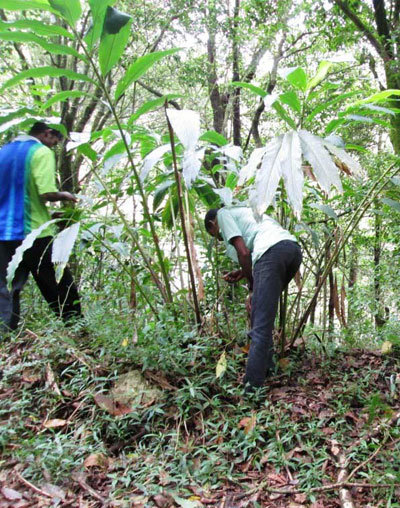News
Cardamom scarcity sees prices hit the ceiling

Cardamom plants in the Knuckles mountain range.
Cardamom, an essential ingredient in countless Sri Lankan sweetmeats and desserts, is now so scarce that a 10g packet–where available–retails for as much as Rs 370 in supermarkets.
Several outlets of popular chains had no stocks. One had a 25g packet for sale at Rs 850. Traders said that, while cardamom had rarely come cheap (it is the third most expensive spice in the world, after saffron and vanilla) prices are now at the steepest they have ever been.
A wholesale spice vendor in Pettah said he did not have cardamom. But he said the bigger pods were now going for around Rs. 16,000 a kilo and the smaller for Rs 14,000.
“What is available for purchase is not of good quality so we did not buy any,” he said. He said the dramatic rise in spices took place last year.
The last of the Indian imports were selling for approximately Rs 18,000 a kilo wholesale while the Sri Lankan one was Rs 11,500, another vendor said.
“Our stock finished around a month ago and now there is not much around for us to buy–certainly, none of the locally-produced pods,” he said.
There is no adequate production of cardamom even for domestic consumption, said Spice Council Secretary Dhammika Gunasekera. He buys the highest quality for Rs 17,000 a kilo and sells them locally under his brand. He also said he had not seen the price exceeding Rs 10,000 in the past six years (having paid Rs 8,000 two years ago).
“We do not even grow 3,000kg of cardamom in the country. If you look at the bulk price at Old Moor Street in Pettah, the vendors would have about two to three grades starting at Rs 12,000 to about Rs 15,000,” he said.
The area under cultivation dropped “drastically” since 2001 after the Knuckles mountain range was declared a conservation forest the previous year, the Institute of Policy Studies (IPS) found.
It reduced further when a 2007 gazette declared the Knuckles to be an Environmentally Protected Area, also covering private lands, and in 2010, the central highlands were designated a UNESCO Natural World Heritage Site.
The range had ideal climatic and soil conditions for cardamom growth, including high elevation, suitable rainfall and earth with high organic matter. There were still plants in those areas from which harvest was gathered. But no development, management or expansion was allowed. And growers were reluctant to start large-scale cultivation because it is labour intensive, high-cost and destruction by animals like monkeys (the worst pest), and porcupines.
“There is no production appeal,” said Department of Export Agriculture (DEA) Director (Research) A. L. S. Dharma Parakrama.
“All the conditions have to be available, including high elevation, but there are no more lands in those areas as increasingly areas are being declared protected,” he said.
“The only way to control the monkey is to use guns. But they can destroy several acres in one-and-a-half hours and once the bush is broken, it will not produce pods again,” Dr. Parakrama said.
While official figures say the area under cultivation was around 2,000 hectares, Dr. Parakrama said these were wrong and includes a large number of plantations that were no longer maintained. Many fell into disuse after a particularly bad pest infestation called thrips which was imported from India. The actual extent was now closer to 100-200 acres, he estimated.
Thrips also affected the quality of the pods. Its widespread nature required the use of pesticides which further increased the cost of production and posed a threat to the environment of the areas in which cardamom was being cultivated. But the sector is now recovering from the attack, Mr. Gunasekera said.
Another factor influencing price is that cardamom no longer arrives in passenger baggage.
“These were not declared but ended up in the market,” Mr. Gunasekera said.
The practice was entrenched that airports in some West Asian countries had kilo packs of cardamom in their duty-free shops targeting Sri Lanka travellers. Not only had this dried up, but imports through official channels were also banned last year.
Local buying was usually seasonal–during festivals like Eid, Christmas or New Year–but there had been more demand in recent years from producers of value-added teas like spiced “chai”, Mr. Gunasekera said.
Meanwhile, with the turmeric shortage and spiraling prices of all other inputs, was raising the price of Sri Lanka curry powders–both for the domestic and international markets–and there were fears producers were already compromising on quality to maintain affordability.
Over the years, recommendations were made to improve production, including by the IPS in a study titled ‘Analysis of Cinnamon, Pepper and Cardamom Value Chains in Sri Lanka’. One of the suggestions was the expansion of cultivations to non-traditional areas and intercropping with perennial cropping systems and forest plantations.
This was now happening, said Mr. Gunasekera. More and more high-grown estates that had forest cover had introduced cardamom along with other spice crops. The DEA had plans to introduce net houses (for protection from animals) and create cardamom villages as well as make it a part of the home garden concept in areas like Kandy and Ratnapura.
“This area was earlier low priority but now the priority is back,” said Dr. Parakrama.
But plans will take time to implement and bear fruit. So, prices would remain high. There was also a global shortfall in production because of climate change and other factors.


